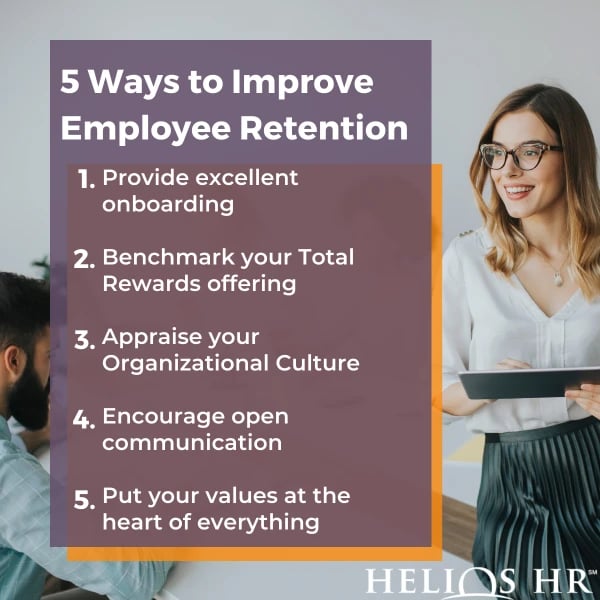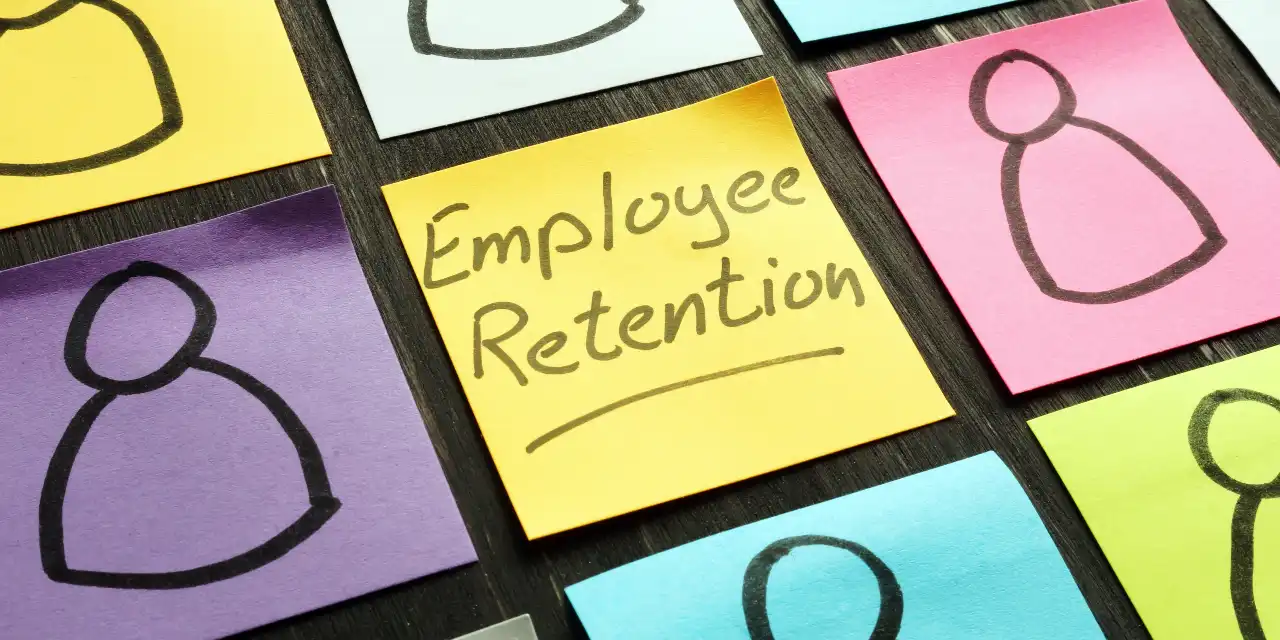By: Connie Maniscalco on June 9th, 2025
Employee Retention Risks: A Complete Guide to Keeping Your Best People
It's a hot labor market right now, and leaders in all industries are struggling to recruit. This could be bad news, even if you're not actively hiring. A competitive labor market means that employers will go to extreme measures to headhunt the best people—including the people on your team.
A proactive employee retention strategy will help you hang onto your best people. Even if you think your team is relatively settled, it’s crucial that you plan ahead and reduce the factors that might cause your people to consider alternative offers.
In this guide, we’re going to walk through the steps involved in creating an effective employee strategy. You’ll also be able to download a free set of engagement survey questions to ask your team.
TABLE OF CONTENTS
- Why good employees quit
- Segment your team with a retention risk matrix
- Engagement data: the key to identifying retention risks
- Five employee retention strategies that work
- What to do if you can’t keep your best employees
Why Good Employees Quit
Nobody stays in the same job forever. Every company experiences some amount of employee churn each year, with people leaving because of retirement, relocation, changes in personal circumstances, or because the employer has let them go.
But some employees quit for avoidable reasons. These resignations often boil down to a combination of push factors and pull factors:
- Push factor: Aspects of their current employment that drive people away
- Pull factor: Features of other potential employers that attract people towards those companies
When people leave, it’s often down to a combination of both. For instance, an employee might not resign purely because they feel underpaid. But if they are underpaid and they get a great offer elsewhere, there is a strong chance that you’ll lose them.
Exit interviews are a great way to find out more about the reasons employees leave. If you’re conducting exit interviews, you might notice some common themes, such as:
- Recognition: Around 64% of people feel undervalued by their employer. Salary plays a big part here, although things like recognition from managers can also make a difference. When people feel that you don’t appreciate them, they’ll leave.
- Career development: Each employee has a plan for the future they want. Employers can either help or hinder those career paths. If you’re not helping, then you can expect to lose your most dynamic staff.
- Culture: Organizations can sometimes develop a toxic culture. The work environment can feel hostile, unwelcoming, or unsupportive. In the long run, this kind of culture will have a big impact on employee satisfaction.
- Work-life balance: The pandemic caused many people to rethink their relationship with their job. Fewer people are willing to spend the majority of their week commuting or sitting in offices. More and more employees are drawn towards employers that allow a healthy balance between work life and personal life.
- Stress and mental health: Did you know that work-related stress contributes to over 120,000 deaths each year? As people become more aware of the importance of mental health, fewer are willing to jeopardize their well-being for a job.
- Interpersonal conflict: Personality clashes are still one of the main drivers of premature resignations. When an employee can’t resolve their conflicts with a coworker or manager, they’re likely to just walk away and start afresh somewhere else.
All of these situations have one thing in common: they’re avoidable.
With the right employee retention strategy in place, you can reduce the push factors that drive away your best people. And the next step in building that strategy is to understand your people a little better.
Segment Your Team with a Retention Risk Matrix
Employee retention strategies tend to take a high-level view of the organization. But staff turnover is something that always happens on a smaller, more personal level.
Each day, any one of your team members could wake up and say to themselves, “today is the day that I quit.” Some people are more likely to make that decision than others.
Equally, the impact of losing a staff member will depend on the person. Some people are mission-critical, and a good employee retention strategy should focus on those key people.
One way to target your retention efforts is to use a retention risk matrix. This is a simple grid that asks two questions:
 Probability: The likelihood that the employee will leave. You can assess this by looking at things like the average market salary for the position and the number of vacant positions available on job boards.
Probability: The likelihood that the employee will leave. You can assess this by looking at things like the average market salary for the position and the number of vacant positions available on job boards.- Impact: How would your business suffer if the employee left? You might struggle if you lost a senior leader, highly skilled employee, or someone with specialist knowledge. To measure this attribute, try to measure how long it would take for a replacement hire to reach full productivity.
You can download a retention risk matrix here:
DOWNLOAD PRINTABLE RETENTION RISK MATRIX
When you start segmenting your team like this, you see four basic categories of employees:
- High probability/High impact: Mission-critical people who are at high risk of departure. Losing them would be a catastrophe, so you’ll need to take urgent action.
- High probability/Low impact: People who are not top performers and are likely to leave soon. While their departure might not have an immediate impact on operations, they will increase your overall employee attrition rate.
- Low probability/High impact: Crucial employees who are unlikely to depart. For these workers, retention means figuring out why they’re staying with you and then consolidating those positives.
- Low probability/Low impact: While these employees are your lowest retention priority, they’re still a vital part of your strategy. These people play a key role in your culture and your overall reputation as an employer.
If you’ve got a big team, you can further segment your workforce by looking at factors such as:
- Career stage: Recent graduates experience different push factors and pull factors than their more experienced colleagues. They may be more willing to accept an interesting new job if offered.
- Demographics: Gender, race, age, and other demographic factors can play a role in employee retention. If you’re seeing high turnover within a specific group, it might indicate a bigger cultural problem within the organization.
- Location: The growing divide between remote workers and on-site workers can have an impact on retention. It’s good to be aware of the factors that influence these groups, as well as workers who are on a hybrid schedule.
After you’ve segmented your team, you’ll immediately see that there’s no such thing as a one-size-fits-all employee retention strategy. Instead, you’ll need an approach that can respond to each person’s unique circumstances.
Engagement Data: The Key to Identifying Retention Risks
There is one rule that applies to everybody. From the intern to the CEO, there is one clue that will tell you if someone is about to quit: Engagement.
What is employee engagement? Basically, it is a measurement of the connection between a person and their job. A highly engaged person exceeds expectations, sees projects through to completion, and always lends a helping hand to colleagues.
Engaged employees believe in the company they work for. They understand and support their employers’ strategic goals. Most importantly, they understand how their day-to-day activities are essential for achieving those goals. Push factors are low for the engaged employee, so it’s unlikely that they’ll search for opportunities elsewhere.
Recent data shows that only 36% of employees report feeling engaged. The majority (51%) are not engaged, while 13% are actively disengaged, which means that they are making plans to leave their current employer.
So, how can you tell if your employees are engaged? The best way to find out is to ask them. You can do this in a number of ways, such as:
- One-to-ones: Give each person a chance to sit with their manager or department head and talk about the job. With focused questions, you should be able to measure employee engagement.
- Stay interviews: Stay interviews are like exit interviews, except that Human Resources speak to people who are not planning to resign. These conversations are a chance to explore what you’re getting right as an employer while giving team members a chance to talk about their improvement suggestions.
- Online surveys: Digital employee surveys can be anonymous, which is essential if you want people to talk about how they really feel. You can run a lengthy engagement survey that focuses on all aspects of employment, or you can create some targeted pulse surveys that look at specific issues like culture or compensation.
Engagement is built on several factors and your studies will have to look at each in turn. Some of the main areas where its helpful to have employee feedback include:
- Compensation and total rewards
- Recognition of hard work
- Organizational culture
- Team relationships, including relationships with managers and peers
- Career progression
- Workload and wellbeing
- Feelings about organizational strategy and goals
One of the big mistakes that leaders often make is to confuse engagement with productivity. An employee’s productivity is often linked to their overall engagement, but many people can hit their targets even when they’re not feeling happy at work. Conversely, someone might struggle with productivity for reasons other than engagement, such as illness or inadequate training.
When you’re measuring engagement, you’re not looking at how much people do. You’re looking at how they do it. Do they like their job? Or would they rather be somewhere else?
Engagement survey results will help you find answers to these questions.
Five Employee Retention Strategies That Work
In the previous steps, we’ve gathered data about employees, engagement and retention. We now know who is thinking about leaving and why.
It means that you have a better idea of your strengths and weaknesses as an employer. An employee retention strategy is about building on those strengths while you try to tackle the weaknesses.
What practical steps can you take in your retention strategy? Here are a few ideas that can help any company attract and retain great people.
1. Get off to a good start with your onboarding
The onboarding process sets the tone for an employee’s entire career at your company. The statistics bear this out, with 66% of companies with onboarding programs reporting higher employee engagement.
Onboarding is a lengthy process. It begins the moment you offer someone a job, and it only ends when they are fully settled in their role. You need to induct them into the organizational culture, help them make connections with their team, and teach them about HR policies.
Not to mention the fact that you have to train and support the employee as they learn to do their job.
A 30-60-90 plan is a great framework for an employee onboarding program. This means having three milestones in the process:
- 30 days: Your new hire should understand the basics and be ready to start contributing.
- 60 days: The person should now be working with some degree of independence.
- 90 days: The employee is now a fully-fledged member of the team with a healthy understanding of your goals, value and culture.
If you can get onboarding right, you’ll lay a solid foundation for low employee turnover.
2. Review your Total Rewards offering
Compensation is both a push factor and pull factor. If your rivals are offering high salaries, that could pull people away. Equally, if your compensation structure is below market average, the feeling of being undervalued could push people towards a rival employer.
But salary isn’t the only thing that you have to offer. The Total Rewards model is a useful way of assessing all of the compensation that your team receives for their hard work. Total Rewards consists of five elements:
- Salary: If employees seem unhappy with their salary, it might be worth working with a compensation consultant. An outside expert can review your current structure, compare it against market data, and help you arrive at a pay scale that’s both fair and sustainable.
- Benefits: Benefits are only of value if they are relevant to the employee. It’s a good idea to talk to the team about their benefits. Find out which benefits they use and which benefits they wish they had.
- Recognition: When employees do a good job, they like to be recognized. Most would like to receive a bonus or performance-related pay increase to show the value of the work. But a sincere thank you can also go a long way and help improve employee engagement.
- Development: Training, coaching, and mentoring are immensely valuable to individuals, who can use these opportunities to grow their careers. Professional development is also good for employers, as it means a deeper pool of available skills.
- Flexibility and well-being: There’s immense value to an employer who lets you work from home when you need to look after kids, or who allows you to schedule your working day around other commitments. Employees also want to see their bosses show a commitment to preventing stress and promoting employee wellness.
The Total Rewards approach allows smaller companies to compete for talent with bigger organizations, even when they can’t match them on salary. People are looking for a good all-around deal. They might resist the lure of a pay increase if their current employer offers meaningful and relevant rewards.
3. Appraise your organizational culture
How do employees experience your organizational culture? It’s a tricky question, but answering it could be the key to long-term employee retention.
Culture defines the employee experience. From the moment someone logs in, they’re immersed in their company’s culture. It impacts their interactions with colleagues, their boss’s expectations, and the way that the employee makes decisions about what to prioritize.
Ultimately, culture decides whether someone stays or leaves. One in five employees resigns over cultural issues, while many people choose to remain with an employer because they find the culture so embracing.
Performing a cultural assessment usually means talking to the team, either in meetings or by using online surveys. You’ll need to look at areas such as:
- Happiness: You can learn a lot about your organizational culture by asking, “are you happy?” A positive culture allows people to feel content, secure, and supported, which leads to an overall feeling of happiness.
- Collaboration: How does the team communicate with each other? How do they deal with team successes and team failures?
- Focus: Which goals are most important to the team? Do they spend their days on long-term strategic work, or are they always putting out fires?
- Diversity, Equality, and Inclusion: Some people may feel excluded if the culture is dominated by one group. For instance, female employees often struggle in companies that have a toxic subculture.
- Stability: Is this a culture where every day is the same, or where every day brings a new challenge? Both can be healthy, as long as people feel supported by tuned-in management.
Fixing cultural issues can require a lot of hard work. You’ll need to engage in honest dialog about problems within the organization, and you will have to commit to addressing those issues. The first step in this process is to appraise your culture and try to create an environment that will drive employee engagement.
4. Encourage open communication
Communication is a sign of healthy employee engagement. Even if you’re having difficult conversations with your team, it shows that they’re invested in the issues and willing to work on them. It also demonstrates that they trust you to listen.
When communication stops, you may have an employee retention issue. Employees who don’t talk things through are likely to start making plans for new opportunities. And you won’t have a chance to change their mind – because you’re not communicating.
If your team needs to communicate more, there are a few things you can do, such as:
- Be honest: Good communication is built on trust, and trust is something you earn through honesty. Share your good news and bad news without trying to spin it in the best possible light. When people see that you trust them with the truth, they will trust you to be honest.
- Have an open-door policy at all levels: Hierarchies can often stand in the way of good communication. Ground-level employees should be able to talk to their boss, or their boss’s boss, or even the CEO if they need to. Encourage everyone to keep their door open for communication.
- Allow anonymous feedback: Anonymity can help you learn the truth about your organization, especially if you have cultural issues. Digital surveys give people a chance to share things that they might otherwise keep to themselves.
- Respond to all queries: Employees will keep quiet if they feel that communication is a waste of time. You can encourage communication by ensuring that every query gets a clear response. For instance, if someone pitches a great idea, keep them posted on how you are implementing that idea.
- Celebrate people who speak their minds: We all tend to take our cues from those around us. If the communicators are the heroes of the team, then everyone else will try to be a better communicator.
Communication can help teams bond, which promotes a positive culture. Open communication also helps to highlight retention risks, which you can then act upon before you lose any people.
5. Put your values at the heart of everything
Your organization’s core documents, such as your vision and mission statement, can be useful retention tools. These things help employees understand your company’s purpose, which makes it easier to see their role in it.
But nothing engages people more than your values. Your values feed into everything: your strategy, your culture, even the way that people interact with each other. When you purposefully live your values, the organization becomes more cohesive and cooperative.
So, how do you live your values? How do values drive your business outcomes? Start by asking these questions:
- What are our values? Have you got a written list of company values? If so, have you updated that list in recent years?
- How do we communicate our values? Are they listed in the back of the employee handbook? Or are they written in big letters on the walls? It’s crucial that you regularly talk about your values, even when speaking to people who’ve been on the team for years.
- How do our values tie into our mission? Any disconnect between values and strategy can have an impact on employee engagement. For example, if one of your core values is that you always put customer experience first, then you need to ensure that your strategy is aimed at delighting and serving your clients.
- How do we live our values each day? Local leaders play a big role in turning values into actions. It’s up to them to talk about values during team meetings or when they’re offering one-to-one guidance. That means that you’ll need to give local leaders the resources and support they require to help uphold your values.
- How do we project our values to the world? Most employees want to be part of something that they’re proud of. You can help make that happen by talking publicly about your values and your culture. Let the world know that you’re a purpose-led organization with clear goals and coherent values.
Values can help make employees feel like they’re a part of something important. When you put your values at the heart of your organization, you inspire a feeling of loyalty that will ultimately result in lower employee turnover.

What to Do if You Can’t Keep Your Best Employees
As we’ve seen in this guide, employee retention basically boils down to two things:
- Analyzing the key drivers of staff turnover
- Taking steps to mitigate those factors
You can’t jump ahead to the second step until you’ve done some meaningful analysis. Exit interviews, stay interviews, and pulse surveys are all rich sources of data.
Regular employee engagement surveys are essential for combating staff turnover. Helios HR’s engagement tool is an excellent platform for finding out more about your team’s current mood. You can see a demo of that platform on YouTube.
When you have data, it's time to take meaningful action. Your specialist HR partner can help identify solutions and build an employee engagement strategy that will make your people choose to stay longer.
Want to talk more about improving your employee retention rate? Schedule a free, no-obligation call today with your Helios HR consultant.





